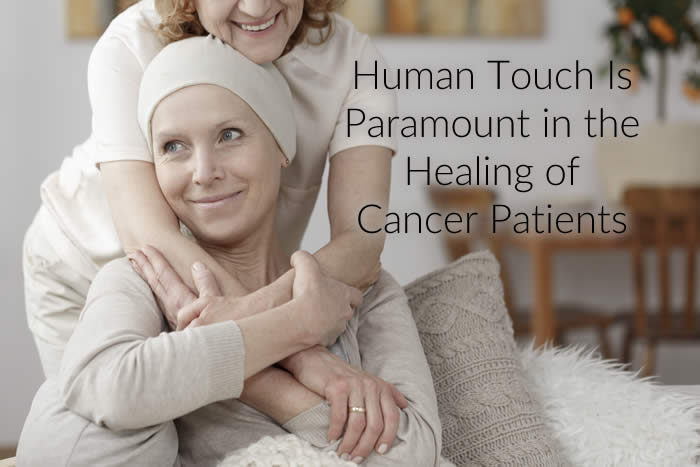

Massage therapy has become a much-needed service for oncology patients and survivors. As cancer treatments have become more sophisticated, the need for human touch remains paramount in the health and healing of cancer patients. The benefits of massage therapy last well beyond treatment rounds of chemotherapy and bouts of radiation as survivors can also safely receive massage therapy.
Cancer features a proliferation of cells which multiply erratically, lose identity and become overly abundant within tissues. Cancer cells re-ignite embryonic mechanisms within cellular nuclei to grow at faster rates than normal. These cells do not function normally, causing tissues and organs to malfunction.
If cancer goes into remission, the proper term is NED stage, which stands for No Evidence of Disease. This means that today there are no signs or symptoms of cancer development. This does not mean forever gone as there is a possibility of cancer recurrence.
Early Warning Signs
Early warning signs to look for include:
- Chronic cough/hoarseness to voice (not related to respiratory disease)
- Sores that do not heal as expected
- Persistent heartburn sensation (not related to acid reflux)
- Persistent shortness of breath (not related to respiratory disease)
- Abnormal changes in bowel activity
- Unusual changes in breast tissue (not related to normal menses cycle changes)
- Unexplained cachexia (weight loss due to disease process)
- Blood present in stool, urine, other body fluids
- Unexplained dull, non-myofascial pain
One important note to indicate here is pain may never present. Oftentimes, cancer patients are depicted on television and movies as patients in dire pain, or pain was the indicator something was wrong within their body. Cancer patients may never experience pain as an indicator of their condition. This misnomer by popular culture can lead many patients astray from their diagnosis soon enough.
Types of Cancer Treatment
Cancer can now be considered a chronic, manageable condition. (1) Early detection is key to ensuring proper care and treatments can be provided promptly. The sooner cancer is detected, the easier it is to combat.
The “big three” treatments most commonly known to cancer patients are radiation, chemotherapy and surgery. These options can be explored and discussed with their physicians.
Other treatment options that may not be as popularly known include immunotherapies, targeted therapies, hormone based therapies, stem cell transplants and precision medicine. These newer innovative treatments may offer significant results for patients. Research is limited for these newer treatments, yet the body of research is expanding annually with promising results.
The Effects of Cancer
Cancer can affect patients on all levels: physical, mental, emotional and spiritual.
- The financial tolls of constant treatments and doctor visits can add to the stress of the disease’s impact upon the physical body.
- Mentally, some patients begin losing hope that healing is possible.
- Emotions may manifest as anger, frustration, sadness, grief, worry and hysteria, amongst many others.
- Spiritually, some patients become more spiritually or religiously inclined whereas others become distant to withdraw from the heartache of perceived broken promises of their faith.
Myth: Classic Massage Therapy Spreads Cancer
When I present Oncology Massage courses in Phoenix, I ask students the first day of class if they were taught that massage therapy could spread cancer. This myth is still presented to newer graduates in some schools today. I dispel this myth within the first few minutes of the course. Classic massage therapy that increases circulation of blood and lymph does not spread cancer. This myth has been dispelled. (2)
One Major Consideration
One major consideration about massage therapy that does need to be shared is the notion of pressure. Cancer has been known to spread through pockets of inflammation through the body. (3) In classes, I present that pressure needs to remain light for cancer patients currently undergoing treatments.
For cancer survivors, a firm pressure can be used. Firm in this case refers to a pressure that can affect muscles yet not create inflammation. Some teachers would describe this as medium pressure, others prefer to use the term light. I present the term “firm pressure” to imply “more than feather light yet not deep enough to cause an inflammatory response.”
That can be a tricky balance to find for a client. I encourage students to often look at the skin while working upon a cancer survivor to see how the skin reacts to touch. If pink/red shades are forming upon the skin a therapist needs to ease the pressure, even if a client is demanding more pressure. For fair individuals whose skin may change color quickly, we need to be sensitive to heat felt upon the skin surface.
Formal Education
I encourage any massage therapist who works with cancer patients and survivors to attend formal education training before accepting these clients. There are nuances that need to be learned that take thoughtful planning and critical thinking.
Factors such as types and timing of treatments administered, side effects experienced, general effects of treatments upon the body, the role of the lymphatic system and alternative cares provided all impact the style, cadence and modalities of massage therapy employed.
Benefits of Massage for Oncology Patients and Survivors

Benefits of massage therapy oncology patients and survivors inform me they receive, include:
- Improved recovery from treatments received
- Better quality sleep
- Decreased pain
- Improved muscle function and daily energy
- Decreased neuropathy, especially in connection with chemotherapy
- Improved elimination
- Decreased headaches
- Overall well-being improved
- Hope that they can recover and defeat cancer
Hope is Powerful
Having worked with this clientele in the past decade, they have taught me valuable lessons on the power of touch. I have witnessed cancer patients and survivors live well past the five-year mark post-diagnosis. Many such clients can live normal expectancies.
I have also learned to include bodywork modalities such as cranial sacral therapy, reflexology, energy work practices and lymphatic drainage either within massage therapy sessions or as stand-alone sessions for many patients.
If the work a massage therapist provides instills hope with the patient, this newly acquired hope is powerful. Hope can become the medium of strength and healing for a patient. Hope that is healing is possible can be the driving force for many people’s recovery.













